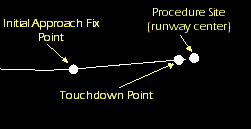A Landing procedure brings an aircraft down from the air to a runway site.
The procedure contains three control points - the procedure site, the Initial Approach Fix point, and the Touchdown point - as indicated in the diagram below. The procedure site is defined as the center of the runway. The Initial Approach Fix point is placed at distance from the procedure site equal to the Initial Approach Fix Range. The Touchdown point is placed at the point that the aircraft will reach ground level after descending on the Glideslope from the Initial Approach Fix point.
Click the image to view a detailed diagram.
Approach Mode
Select the type of landing from:
- Standard Instrument Approach - The aircraft will perform a landing following standard IFR flight rules; it will use Enroute methodology to reach the Initial Approach Fix Range at the specified altitude, maneuvering as specified to achieve those goals, and then descend to landing along the glideslope.
- Intercept Glideslope - The aircraft will perform a landing following VFR flight rules; it will use Basic Point to Point methodology to fly to the Initial Approach Fix Range and then descend to landing along the glideslope.
- Enter Downwind Pattern - The aircraft will fly a pattern that takes it to the downwind end of the runway to begin its landing.
Runway Heading
Select the runway heading The direction that the aircraft is pointing. that the aircraft will use. The first numerical value indicates the bearing relative to magnetic north and the second value indicates the bearing relative to true north. These values are derived from the runway site definition.
Landing Options
| Option | Description |
|---|---|
| Approach Alt Above Runway | The aircraft's altitude at the Initial Approach Fix Range. The altitude is constrained by the lowest ceiling value of the active performance models in the current mission phase. |
| Level Off Maneuver |
A level off maneuver is used to bring an aircraft to the approach altitude specified for the landing procedure, if the aircraft is unable to attain that altitude during the course of the procedure. Select from the following leveling off options:
|
| Approach Fix Range | The range from the reference point of the runway at which the aircraft begins its landing approach. |
| Relative to |
Select the reference point on the runway for the Approach Fix Range:
|
| Abeam Distance | The distance from the runway that the aircraft will fly the parallel leg of the landing pattern. |
| Abeam Altitude | The altitude at which the aircraft will fly the parallel leg of the landing pattern. |
| Final Turn | The direction of the turn that the aircraft will make when it lines up over the runway to land. |
| Glideslope | The angle from horizontal on which the aircraft descends to touchdown. |
| Runway Altitude Offset | The altitude offset above the ground level of the procedure site. |
| Use Terrain for Runway Altitude | Select this check box to use terrain data to define the runway's ground level altitude. Aviator will find the highest altitude along the runway and use that value for its landing roll. |
| Touch and Go |
Select this check box to end the procedure at wheels down. You can then follow this landing procedure with a Takeoff procedure to simulate a "touch and go" landing. The aircraft will, if needed, accelerate to the takeoff speed as specified in the performance model as part of the subsequent takeoff procedure. The subsequent takeoff procedure can be placed in a new phase. It must still be the very next procedure. |
Enroute Options
Enroute Options define maneuvering performance characteristics of the aircraft during enroute segments of the procedure.
Table - Enroute Options Parameters![]()
Enroute Cruise Airspeed
Enroute Cruise Airspeed parameters define the airspeed performance characteristics of the aircraft during enroute segments of the procedure.
Table - Enroute Cruise Airpseed Parameters![]()
Enroute Turn Direction
Enroute Turn Direction parameters define the direction that the aircraft will turn during enroute segments of the procedure.
Table - Enroute Turn Direction Parameters![]()
Vertical Plane Options
Vertical Plane Options parameters define the flight path angle of the aircraft during enroute and arc segments of the procedure.
| Parameter | Description |
|---|---|
| Radius Factor | The Radius Factor is the maximum amount - expressed as a multiplier - that the radius of a vertical curve will be increased to minimize the flight path angle required to complete it. The full circles that correspond (or are tangent) to the start/stop curves at the extended radius may not intersect if the Radius Factor is set high enough. This parameter is a limit and may not actually be achieved due to the requirement to generate an appropriate curve sequence. You can adjust the slider or enter the value manually in the box, with the minimum value being 1 and the maximum value being 10. |
| Min Enroute FPA | The minimum pitch angle of the flight path during enroute segments of the procedure. |
| Max Enroute FPA | The maximum pitch angle of the flight path during enroute segments of the procedure. |
